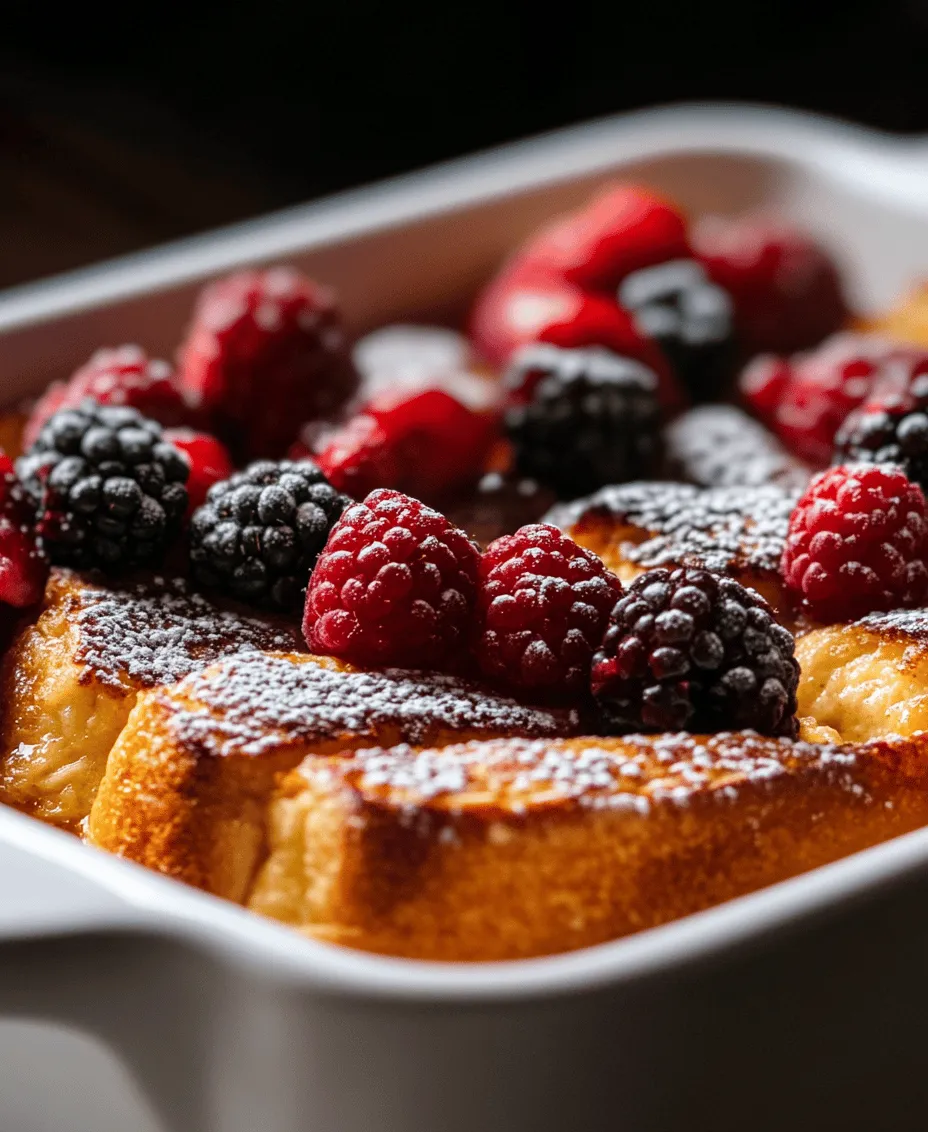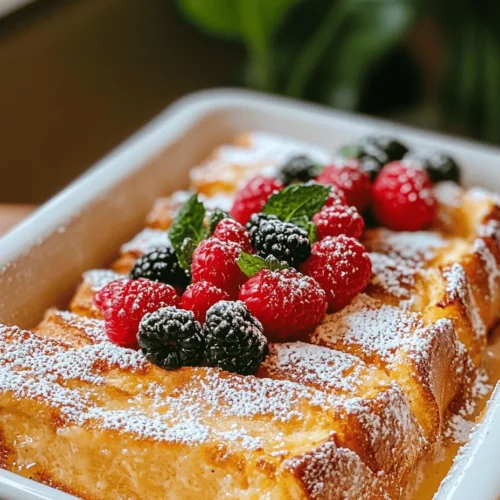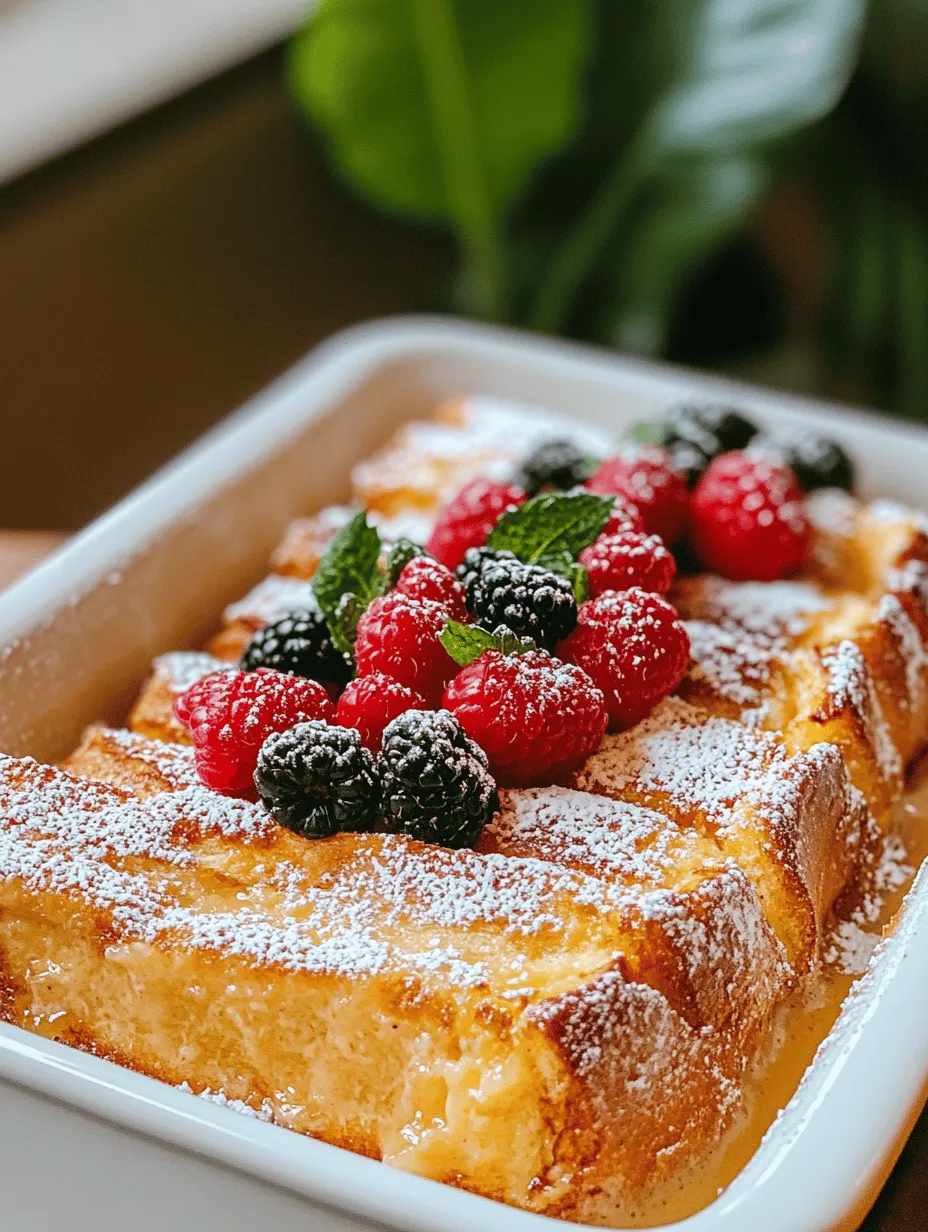In the world of breakfast dishes, few can rival the decadence and indulgence of crème brûlée French toast. This delightful twist on the classic French dessert combines the creamy richness of crème brûlée with the comforting familiarity of French toast, making it the perfect choice for special occasions or leisurely weekend brunches. Imagine waking up to the aroma of sweet vanilla and warm spices, with each bite offering a perfect blend of creamy, crunchy, and soft textures. In this article, we will explore the ingredients, preparation, and baking techniques that make this dish a standout, along with the history and variations to inspire your culinary creativity.
Understanding the Ingredients
Creating a memorable crème brûlée French toast begins with selecting the right ingredients. Each element plays a crucial role in achieving the desired flavor and texture, ensuring that your dish is not only delicious but also visually appealing.
The Importance of Brioche Bread
At the heart of any French toast is the bread, and for crème brûlée French toast, brioche is the undisputed champion. This luxurious bread is known for its rich, buttery flavor and soft, airy texture. Brioche is made with a higher proportion of eggs and butter than regular bread, which provides it with a unique density that allows it to soak up the custard mixture without becoming overly soggy.
The ideal brioche for this recipe should be slightly stale, as this helps it absorb the custard better. Fresh brioche can be too soft and may fall apart during the soaking process. If you have freshly baked brioche, simply leave it out for a few hours or even overnight to dry out slightly before using it in your French toast recipe. This step is essential for achieving the perfect balance of flavors and textures in your crème brûlée French toast.
Key Dairy Ingredients: Eggs, Heavy Cream, and Milk
The custard base of crème brûlée French toast is what sets it apart from traditional French toast. The key ingredients in this custard mixture include eggs, heavy cream, and whole milk.
– Eggs: Eggs are the backbone of the custard, providing structure and richness. They help bind the ingredients together and create that luxurious, creamy texture we associate with crème brûlée. When whisked together, the eggs create a smooth emulsion that is critical for achieving the right consistency.
– Heavy Cream: The inclusion of heavy cream in the custard mixture is essential for achieving the rich, velvety mouthfeel that crème brûlée is known for. Heavy cream has a higher fat content compared to regular milk, which contributes to the creaminess of the dish.
– Whole Milk: While heavy cream adds richness, whole milk provides a lighter texture that balances the overall custard. The combination of these dairy ingredients ensures a perfect custard that coats the brioche beautifully, giving you that indulgent experience with every bite.
Sweeteners and Flavor Enhancers
To elevate the flavor profile of your crème brûlée French toast, you’ll need to consider your sweeteners and flavor enhancers.
– Granulated Sugar and Brown Sugar: Both sugars play a vital role in the custard and the topping. Granulated sugar is often used in the custard mixture to sweeten it, while brown sugar is ideal for the caramelized topping. The molasses in brown sugar adds a deeper flavor and helps create that signature crispy top layer when caramelized.
– Vanilla Extract and Cinnamon: These ingredients are not just for flavor; they also enhance the overall experience of the dish. Pure vanilla extract imparts a warm, sweet aroma that complements the custard beautifully, while ground cinnamon adds a hint of spice that ties the flavors together. This aromatic duo transforms your crème brûlée French toast into a fragrant brunch masterpiece.
Optional Garnishes: Fresh Berries and Powdered Sugar
While the crème brûlée French toast is a showstopper on its own, garnishing it with fresh berries and a dusting of powdered sugar can elevate both its appearance and taste.
– Fresh Berries: Berries such as strawberries, blueberries, raspberries, or blackberries offer a burst of freshness and acidity that contrasts beautifully with the rich custard. Their bright colors also add visual appeal to your dish. When selecting berries, opt for ripe, in-season varieties for the best flavor.
– Powdered Sugar: A light sprinkle of powdered sugar not only enhances the visual appeal with a touch of elegance but also adds a hint of sweetness. This simple garnish can make your crème brûlée French toast look like it belongs in a fancy café.
Step-by-Step Preparation
Now that we have a solid understanding of the ingredients, let’s dive into the step-by-step preparation of overnight crème brûlée French toast. This process is straightforward and allows for a carefree morning, especially when you prepare it the night before.
Whisking the Custard Mixture
The first step in preparing your crème brûlée French toast is to create the custard mixture. Here’s how to do it:
1. Gather your ingredients: In a large mixing bowl, combine 4 large eggs, 1 cup of heavy cream, and 1 cup of whole milk.
2. Add the sweeteners and flavorings: To the egg and milk mixture, add ½ cup of granulated sugar, ½ cup of brown sugar, 1 tablespoon of pure vanilla extract, and 1 teaspoon of ground cinnamon.
3. Whisk until smooth: Using a whisk, gently beat the mixture until it is fully combined and smooth. This step is crucial to ensure that the eggs are evenly distributed and that you achieve a uniform custard without any lumps.
4. Taste and adjust: Before moving on, taste the custard mixture. Adjust the sweetness or flavorings according to your preference, keeping in mind that the bread will absorb some sweetness.
Arranging the Brioche Bread
With the custard mixture ready, it’s time to prepare the brioche:
1. Slice the bread: Take your brioche loaf and slice it into thick pieces, about 1 to 1.5 inches thick. This thickness will provide the ideal surface area for soaking while maintaining enough structure.
2. Layer the bread: In a greased 9×13-inch baking dish, layer the brioche slices in a single layer, slightly overlapping them. This arrangement ensures that every piece of bread is well-soaked in the custard mixture.
3. Pour the custard: Once the bread is arranged, carefully pour the custard mixture over the brioche. Ensure that each slice is well-coated and immersed in the liquid. If necessary, gently press down on the bread to help it absorb the custard.
Refrigeration: The Overnight Soak
The key to achieving the best flavor and texture lies in allowing the brioche to soak in the custard overnight:
1. Cover the dish: Once the custard has been poured over the brioche, cover the baking dish tightly with plastic wrap or aluminum foil. This step prevents the custard from drying out and allows the flavors to meld together.
2. Refrigerate: Place the covered dish in the refrigerator and let it soak for at least 4 hours, preferably overnight. This soaking process allows the brioche to absorb the custard, resulting in a creamy, custardy interior.
3. Prepare for baking: Before baking, remove the dish from the refrigerator and let it sit at room temperature for about 30 minutes to ensure even cooking.
Baking the Crème Brûlée French Toast
Once you’ve allowed the brioche to soak overnight, it’s time to bake your crème brûlée French toast to perfection.
Preheating the Oven
1. Set your oven temperature: Preheat your oven to 350°F (175°C). Preheating is crucial as it ensures that the custard cooks evenly and the brioche becomes golden and crispy.
2. Use the right oven rack: Position the oven rack in the center of the oven. This will allow for optimal air circulation and even cooking.
Adding the Brown Sugar Topping
To achieve that iconic crème brûlée topping, you’ll need to add brown sugar before baking:
1. Sprinkle the brown sugar: After removing the soaked bread from the refrigerator, sprinkle a generous layer of brown sugar over the top of the brioche. This layer will caramelize during baking, creating a crispy, brûléed crust.
2. Distribute evenly: Use your fingers to ensure the brown sugar is evenly distributed. This will help create a uniform caramelized top that is both crunchy and sweet.
3. Understanding caramelization: As the French toast bakes, the sugars will melt and caramelize, creating that signature crispy layer. Keep an eye on it, as the baking time may vary depending on your oven.
With these steps, you’re well on your way to creating a stunning and delicious overnight crème brûlée French toast. Each bite promises a delightful experience that beautifully marries the richness of crème brûlée with the comforting familiarity of French toast. Get ready to impress your family and friends with this indulgent breakfast dish that is perfect for any special occasion or leisurely brunch.

Baking Time and Monitoring Progress
Once you have prepared your Overnight Crème Brûlée French Toast and allowed it to soak overnight, it’s time for the baking phase. The recommended baking duration for this dish is approximately 30 to 40 minutes at a temperature of 350°F (175°C). However, baking times can vary based on your oven’s accuracy, so it’s crucial to keep an eye on your creation as it cooks.
To determine if your French toast is ready, look for specific indicators of doneness:
1. Color: The top should achieve a golden-brown hue, signifying that it has cooked through yet retains a custard-like softness inside.
2. Bubbling: You will notice bubbling around the edges of the dish, which is a good sign that the custard is setting. This bubbling suggests that steam is escaping, allowing the inside to reach the perfect texture.
As you approach the end of the baking time, gently insert a knife or toothpick into the center. If it comes out clean or with only a few crumbs, your French toast is ready. If it appears wet, give it an additional 5 to 10 minutes, checking frequently to avoid overcooking.
Caramelizing the Topping
The crowning glory of your Overnight Crème Brûlée French Toast is the caramelized sugar topping. There are two popular methods to achieve this: using a kitchen torch or the broiler method. Each has its unique benefits and requires careful attention to ensure perfect results.
Using a Kitchen Torch
If you have a kitchen torch, here’s how to use it safely and effectively:
1. Prepare the Sugar: Once your French toast is baked and cooled slightly, sprinkle an even layer of granulated sugar over the top. Make sure the sugar covers the surface without clumping.
2. Light the Torch: Follow the manufacturer’s instructions to ignite the torch. Ensure you’re in a well-ventilated area, away from flammable materials.
3. Caramelize the Sugar: Hold the torch about 2 inches above the sugar. Move the flame in a circular motion to evenly distribute the heat. You’ll see the sugar start to melt and bubble, transitioning to a golden brown color.
4. Cool and Serve: Once the sugar has caramelized to your liking, allow it to cool for a minute. This cooling period will create a hard, glass-like shell that is a hallmark of crème brûlée.
Tips for Achieving the Perfect Caramelized Layer:
– Use superfine sugar for a more consistent melt.
– Avoid holding the flame too close, as this can burn the sugar rather than caramelize it.
– If you want a more pronounced flavor, consider using brown sugar instead of white, as it will add a hint of molasses.
Broiler Method for Caramelization
If you don’t have a kitchen torch, the broiler method is an excellent alternative:
1. Prepare the Sugar: Similar to the torch method, sprinkle a layer of granulated sugar evenly over the surface of the baked French toast.
2. Preheat the Broiler: Set your oven to broil and allow it to preheat for about 5 minutes.
3. Broil the French Toast: Place the dish under the broiler, keeping a close watch. The sugar will begin to melt and bubble within a couple of minutes.
4. Watch for Signs of Burning: This method can quickly go from perfectly caramelized to burnt, so stay vigilant. Remove the dish from the oven once the sugar has turned a deep amber color.
Advantages and Disadvantages of Each Method:
– Kitchen Torch: Allows for precise control and can be done table-side for a dramatic effect. However, it requires practice and a steady hand.
– Broiler Method: Easier for beginners and can caramelize larger surfaces at once, but it demands close monitoring to avoid burning.
Serving Suggestions
Once your Overnight Crème Brûlée French Toast is caramelized and ready to serve, presentation becomes key for a delightful brunch experience.
Presentation Ideas
1. Plating: Cut the French toast into squares or triangles and arrange them on a serving platter. Dust with powdered sugar for a touch of elegance.
2. Seasonal Touches: Incorporate seasonal fruits like berries, sliced peaches, or poached pears around the dish. Fresh mint leaves or edible flowers can add a pop of color and freshness, making your dish visually appealing.
3. Drizzle of Sauce: Consider drizzling some warm maple syrup or a flavored cream sauce around the plate for added flavor and decoration.
Flavor Pairing Recommendations
To elevate your brunch spread, consider these complementary drinks and sides:
– Drinks: A classic pairing for crème brûlée French toast is a robust cup of coffee or a creamy latte. If you prefer something more refreshing, a mimosa or a fruity sangria can add a festive touch.
– Additional Sides: Serve with crispy bacon or sausage links for a savory contrast. A light side salad can also balance the richness of the French toast.
Exploring Variations
Your Overnight Crème Brûlée French Toast can be customized in various ways, allowing you to cater to different tastes and preferences.
Flavor Infusions and Add-Ins
1. Custom Custard: Experiment with different flavor extracts such as almond, orange, or coconut. A pinch of cinnamon or nutmeg can also elevate the custard base.
2. Fruits and Nuts: Incorporate fresh fruits like bananas or strawberries into the custard before baking for added sweetness. Chopped nuts, such as pecans or walnuts, can provide a delightful crunch.
Alternative Bread Choices
While brioche is a classic choice for this recipe, consider these alternatives:
– Challah: Its slightly sweet flavor and dense texture make it an excellent option for soaking up custard.
– Whole Grain Bread: For a healthier twist, whole grain or multigrain bread can add nuttiness and fiber, though it may yield a denser texture compared to brioche.
Each bread type has its pros and cons, so choose one that aligns with your desired flavor profile and texture.
The History of French Toast and Crème Brûlée
Understanding the origins of the dishes that inspired your Overnight Crème Brûlée French Toast adds depth to your culinary experience.
Tracing the Origins of French Toast
French toast, known as “pain perdu” in France, dates back to ancient times when stale bread was soaked in a mixture of milk and eggs to prevent waste. It has since evolved into a breakfast staple across cultures, with variations found in many countries. For example, in Spain, it is known as “torrijas,” often flavored with cinnamon and served during Holy Week.
The Evolution of Crème Brûlée
Crème brûlée, on the other hand, is believed to have originated in France in the 17th century. Its name translates to “burnt cream,” referring to the caramelized sugar topping. Over time, this elegant dessert has seen numerous adaptations, leading to the delightful fusion of crème brûlée with the French toast tradition.
Conclusion: A Decadent Breakfast Awaits
Overnight crème brûlée French toast is more than just a breakfast dish; it’s an experience that combines the rich traditions of French cuisine with the comfort of a home-cooked meal. By following the detailed steps outlined in this article, you can create a dish that not only satisfies your taste buds but also impresses your guests. The combination of creamy custard, crispy caramelized sugar, and soft brioche will make this recipe a beloved addition to your breakfast repertoire.
Enjoy the process of preparation and the delightful results that await you at the table. Whether you serve it for a special occasion or a cozy weekend brunch, this decadent dish promises to be a highlight of any gathering. So gather your ingredients, unleash your culinary creativity, and savor the joy of sharing this exquisite treat with your loved ones.



